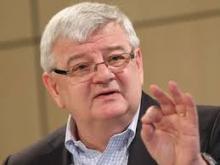This year marks the centennial of the outbreak of World War I, which is reason enough to reflect on what this seminal European catastrophe teaches us today.
Indeed, the Great War’s consequences for international relations and the global system of states continue to be felt. So, have we learned anything from the policy failures of governments, institutions and international diplomacy that occurred in the summer of 1914?
Large parts of the northern hemisphere continue to struggle with the legacies of the great European empires — Habsburg, Russian and Ottoman — that collapsed in the wake of World War I, or whose decline, like that of the British Empire, was initiated by the war and sealed by its even bloodier sequel a generation later.
The resulting fracture zones — in the Balkans and the Middle East, for example — are the source of some of today’s gravest risks to regional and even world peace.
After the Cold War’s end and the collapse of the Russian Empire’s Soviet successor, war returned to the Balkans under very similar conditions to those that prevailed in the period before 1914, with aggressive nationalism ultimately reconfiguring the disintegrating Yugoslavia as six separate states.
Of course, Serbian President Slobodan Milosevic, whose call for a “Greater Serbia” triggered the war, was not alone: For a moment, Europe was in danger of reverting to the confrontation of 1914, with France and the United Kingdom supporting Serbia, and Germany and Austria favouring Croatia.
Fortunately, there was no relapse, because the West had learned its lessons from historical mistakes.
Today, three factors loom large in the avoidance of disaster: the United States’ military presence in Europe, the progress of European integration, and Europe’s abandonment of great-power politics.
Yet there is no point in fooling oneself: Only as long as the Balkan countries believe in the European Union and the benefits of membership will today’s precarious peace in the region become permanent.
No such hope currently exists for the Middle East, whose contemporary political borders were largely established by Britain and France during World War I, when the diplomats Mark Sykes and François Georges-Picot negotiated the division of the Ottoman Empire.
Likewise, the creation of Israel harks back to the 1917 Balfour Declaration, whereby the subsequent British mandatory power in Palestine supported the establishment of a national home for the Jewish people.
The Middle East created back then is, more or less, the Middle East today. Yet we are now witnessing its disintegration, because the Sykes-Picot design always implied a strong external hegemonic power (or two) able and willing to maintain stability by channelling (or suppressing) the region’s numerous conflicts.
Great Britain and France, the first hegemonic powers, were succeeded by the US and the Soviet Union — and, finally, by the US alone.
America’s misadventure in Iraq, its exhaustion as a world power, and its unwillingness to maintain its previous level of commitment to the region have rendered the Sykes-Picot structure untenable, because no other external force for order is available.
The resulting vacuum has been filled by various currents of political Islam, terrorism, protest movements, uprisings, secession attempts by national or religious minorities and aspiring regional hegemons (Iran and Saudi Arabia).
Indeed, the partial withdrawal of the US implies that the end of the enforced stability of the old Middle East will not spare the Sykes-Picot borders.
Developments in Syria and Iraq already suggest as much, and the future of Lebanon and Jordan has become increasingly uncertain.
One of the few positive features of the region is that no global power rivalries are currently playing out there.
But the regional struggle for mastery between Iran and Saudi Arabia (with Israel as a third actor) could prove to be all the more dangerous, given the prevailing — and deeply entrenched — mindset of traditional power politics.
Institutions and traditions supporting cooperative conflict resolution hardly exist in the region.
The memory of 1914 may trigger the most concern in East Asia, where all the ingredients of a similar disaster have accumulated: nuclear weapons, the rise of China as a global power, unresolved territorial and border disputes, the division of the Korean Peninsula, historical resentments, an obsession with status and prestige, and hardly any cooperative conflict-resolution mechanisms.
Distrust and power politics are the order of the day.
And yet there are grounds for optimism in East Asia.
The world has changed dramatically since the summer of 1914. At the time, the world’s population was two billion; now it is seven billion.
This, together with the communications revolution, has created even more interdependencies and has forced more cooperation upon governments — as has the continued presence of the US as a stabiliser in the region, which has proved to be indispensable.
Moreover, while nuclear weapons pose a continuing danger, they also inhibit the risk of war as a means of power politics by making mutual destruction a certainty.
Military technology, the mindset of politicians and citizens, the structure of international diplomacy and much more have changed in the century since World War I erupted.
And, yes, we have even learned a few things from history, which has made the world safer. But, lest we forget: in the summer 1914, most actors regarded the impending disaster as an impossibility.
The writer, Germany’s foreign minister and vice chancellor from 1998 to 2005, was a leader of the German Green Party for almost 20 years. ©Project Syndicate/Institute for Human Sciences, 2014. www.project-syndicate.org













